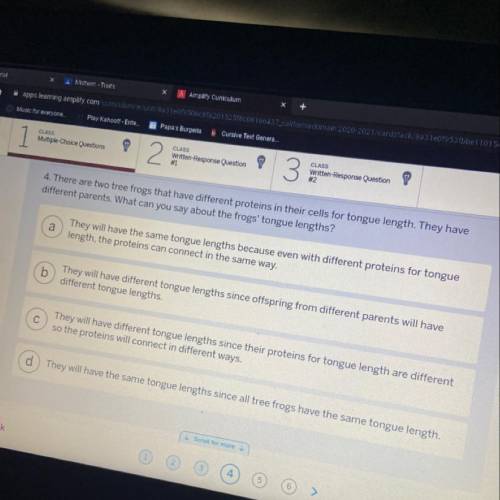
Biology, 12.02.2021 01:00 NicoleParker
4. There are two tree frogs that have different proteins in their cells for tongue length. They have
different parents. What can you say about the frogs' tongue lengths?
а
They will have the same tongue lengths because even with different proteins for tongue
length, the proteins can connect in the same way.
b
They will have different tongue lengths since offspring from different parents will have
different tongue lengths.
С
They will have different tongue lengths since their proteins for tongue length are different
so the proteins will connect in different ways.
d They will have the same tongue lenoths since all tree frogs have the same tongue


Answers: 2


Another question on Biology

Biology, 21.06.2019 19:10
What have we learned from fossil evidence about evolution? a) it is an abrupt change. b)the process is observable. c) it takes place during one lifetime only. d)the most complex traits are always selected.
Answers: 2

Biology, 22.06.2019 09:30
Juan and carol were studying invertebrates in biology. they knew that segmented or earth worms preferred a dark, moist habitat. during this lab, they would be investigating the responses of organisms called planaria or dugesia tigrina. these were simple flatworms that still had a one-way digestive system and a very simple nervous system. juan and carol placed the planaria in a petri dish containing cool, distilled water that was partially covered with black paper. they shined a light on the dish. next, they removed the paper and placed a small amount of chicken liver at one end of the dish. they added a few large salt crystals to the water. finally, they added drops of hot water to the cool water in the petri dish. their results can be seen in the data table. according to their experiment, all but one conclusion is valid.
Answers: 1

Biology, 22.06.2019 10:30
Subduction zones form when an oceanic plate collides with another oceanic plate or continental plate. the continental crust is lighter and less dense than oceanic crust. continental crust's density is approximately 2.7 grams per cubic centimeter. oceanic crust is thinner and the average density is about 3.3 cubic centimeters. when the two crustal plates converge the oceanic plate always bends and subducts beneath a continental plate. once the oceanic crust subjects, the rocks are subjected to changes in heat and pressure. because of this, we would expect to find rocks in the area of a subduction. a) clastic b) igneous c) metamorphic d) sedimentary
Answers: 2

Biology, 22.06.2019 11:30
28. how many linkage groups will be formed by homogametic organism with 28 chromosomes?
Answers: 2
You know the right answer?
4. There are two tree frogs that have different proteins in their cells for tongue length. They have...
Questions



Mathematics, 13.10.2020 01:01


English, 13.10.2020 01:01

Chemistry, 13.10.2020 01:01




Spanish, 13.10.2020 01:01

Mathematics, 13.10.2020 01:01


Biology, 13.10.2020 01:01

Mathematics, 13.10.2020 01:01



Biology, 13.10.2020 01:01

Mathematics, 13.10.2020 01:01

Mathematics, 13.10.2020 01:01



